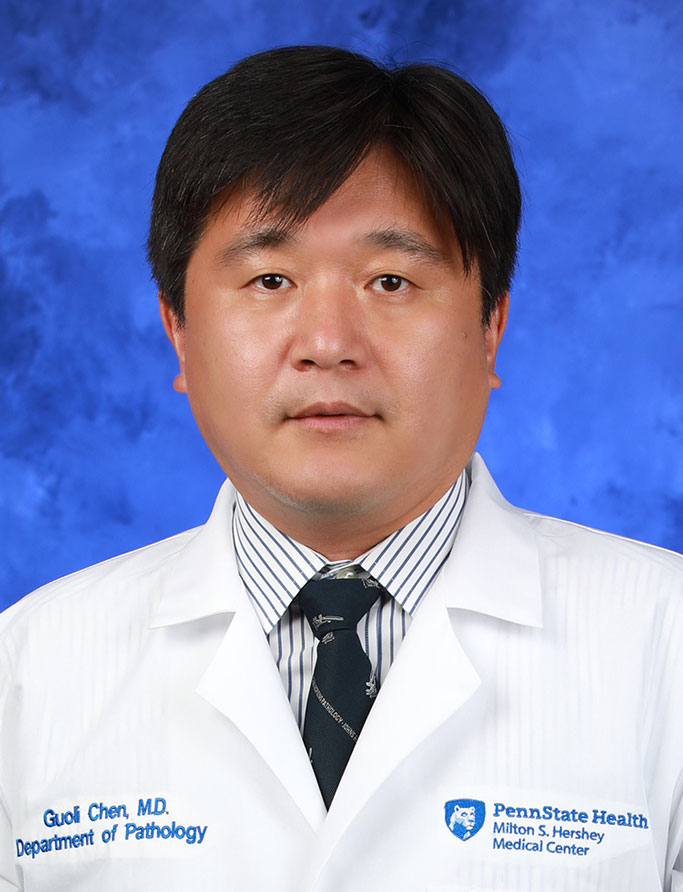Jump to topic
Search
Program Details
The Surgical Pathology Fellowship includes training in all aspects of adult and pediatric surgical pathology. Applicants should be board-certified or board-eligible in combined anatomic/clinical pathology or anatomic pathology only.
Learn More about the Fellowship
The aim of the Surgical Pathology Fellowship is to assure competency in general surgical pathology through mandatory rotations in all subspecialty areas; to provide flexibility for advanced study in subspecialties determined by the fellow; to develop habits of inquiry and critical thinking through a required research project; to advance the fellow’s knowledge of systems issues through required participation in a QI project; and of most importance, to further advance the fellow’s medical knowledge, build the fellow’s professional confidence, and develop the fellow’s skills as an educator, by having the fellow serve in a variety of teaching roles.
The fellow will be evaluated on the six core competencies of Patient Care, Medical Knowledge, Practice Based Learning and Improvement, Systems Based Practice, Interpersonal Skills and Communication, and Professionalism, through self, peer, staff and faculty evaluations.
The fellow will complete mandatory rotations in all subspecialty areas, as aforementioned; this comprises nine two-week rotations. The fellow, if deemed competent, will advance to a teaching role after these mandatory core rotations. The benefit of being in a one-on-one teaching role needs to be balanced against the benefit of additional experience in the subspecialties most needed by the fellow. This will be accomplished by requiring that a minimum of five two-week rotations during the second block be in a teaching role with a junior resident, with the flexibility to select the remaining three two-week cycles according to need for additional experience, regardless of whether a junior resident is on that service or not.
The fellow will have six two-week elective rotations. The final four weeks of the year are vacation time.
The fellow will complete a Quality Assurance Project and present this in the spring. The fellow will perform a research project with the expectation that the project be submitted for presentation or publication during or shortly after the end of the fellowship year.
The fellow will prepare and present three themed hour-long conferences at the Surgical Pathology Unknowns Conference; this is felt to be of more educational value than a larger number of isolated case presentations. The fellow will serve in a leadership role in Surgical Pathology Unknowns Conference by routinely being the individual who drives the slides and leads the residents in discussion of the cases.
In order to develop competence and confidence presenting in interdisciplinary conferences, the fellow will have a longitudinal experience with a single tumor board, as this develops familiarity with subject matter and clinical decision making in that clinical discipline as well as building a relationship with clinical colleagues in a particular discipline. The fellow will be allowed to chose a tumor board if he or she enters the program with a subspecialty interest. Otherwise, the fellow will be assigned to the GU tumor board, as this is a good clinical group to work with; the cases are interesting and varied, the preparation time is not unmanageable, and it is a real-time patient management conference.
Another aspect of the fellow’s training in the area of education is program review. The fellow will participate with the Fellowship Committee in the annual review of the Fellowship Program to offer insight, perspective and suggestions for improvement.
General Application Information
Applications are currently being accepted for 2024-2025.
To apply, submit the information listed here via email to esmith31@pennstatehealth.psu.edu.
A complete application will include:
- CAP Standardized Pathology Fellowship Application (found under “Fellowship Resources” at this link)
- Cover letter with personal statement
- Curriculum vitae
- Copy of USMLE test scores (or equivalent)
- Letter of recommendation and verification of training from current/most recent program director
- Two to three additional letters of recommendation
Letters of recommendation may be emailed directly by the references.
Application Requirements
Applicants should:
- Be board-certified or board-eligible in combined anatomic/clinical pathology or anatomic pathology only
- Be eligible for PA license
- Be U.S. citizens or holders of green cards or J-1 visas
Virtual Tour
Penn State Health
Penn State Health is a multi-hospital health system serving patients and communities across 29 counties of Pennsylvania. Its mission is to improve health through patient care, research, education and community outreach.
In December 2017, the system partnered with Highmark Health to facilitate creation of a value-based, community care network in the region. The shared goal of Highmark and Penn State Health is to ensure patients in the community are within:
- 10 minutes of a Penn State Health primary care provider
- 20 minutes of Penn State Health specialty care
- 30 minutes of a Penn State Health acute care facility
Learn more about Penn State Health

Penn State Health Children’s Hospital (left), Penn State Health Milton S. Hershey Medical Center (center) and Penn State Cancer Institute (right)
Penn State Health Milton S. Hershey Medical Center
500 University Dr., Hershey, Pa., 17033 (Derry Township, Dauphin County)
- The health system’s 647-bed flagship teaching and research hospital
- The only medical facility in Pennsylvania accredited as both an adult and a pediatric Level I (highest-level) trauma center
- Dedicated surgical, neuroscience, cardiovascular, trauma and medical intensive care units
- Accredited Life Lion critical-care transport providing more than 1,100 helicopter and approximately 750 ground ambulance transports per year
- More than 1,300 faculty members and more than 650 residents and fellows
- Approximately 29,000 admissions, 73,000 emergency department visits, 1.1 million outpatient visits and 33,000 surgical procedures annually
- Designated as a Magnet hospital since 2007
Learn more about Milton S. Hershey Medical Center
Penn State Health Children’s Hospital
600 University Dr., Hershey, Pa. 17033 (Derry Township, Dauphin County)
- An eight-story, 263,000-square-foot-facility built in 2013 and expanded in 2020
- 146 licensed pediatric beds, 18 acute care beds and a 56-bed neonatal intensive care unit
- Level IV (highest-level) neonatal intensive care unit
- Level I quaternary (highest-level) pediatric intensive care unit
- Level I (highest-level) pediatric trauma center designation
- Intermediate care unit
- Dedicated pediatric operating rooms
- More than 150,000 pediatric outpatient visits and approximately 5,000 pediatric patient discharges annually
Welcome to Hershey
More About Hershey
Interested in learning more about living and working in Hershey, Pa.? See details here:
Wellness, including emotional, spiritual, social and physical health, is a crucial component to training and to becoming a professional, compassionate and resilient physician. Self-care is a skill which must be continually practiced and reinforced. Penn State College of Medicine and Penn State Health are committed to addressing wellness among residents and fellows, with multiple resources readily available.
Institutional resources
- Visit BeWell – a health program designed to support Penn State Health employees
- See Penn State College of Medicine wellness resources here
- Employee Health Care Concierge and Case Management Service
- Partners in Medicine
Moving to a new city with your family does not have to be stressful. Residency programs have assisted many significant others with finding employment. There is also a GME-Wide Partners in Medicine (PIM) group that offers networking opportunities as well as various social and community oriented activities. - The Doctors Kienle Center for Humanistic Medicine
- Active and easily accessed Office of Professional Mental Health
Graduate medical education resources
Institutional Resources
Penn State Health and Penn State College of Medicine celebrate, embrace and support the diversity of all patients, faculty, staff, students and trainees.
Office for Diversity, Equity and Inclusion
In keeping with this, Penn State Health has an active Office for Diversity, Equity and Inclusion with various programs, networks and resource groups, including:
- Talks and lectures on diversity, equity and inclusion through the Inclusion Academy
- Regular events on topics such as eradicating racism and creating a culture of inclusiveness
- Many Business Employee Resource Groups (BERGs), including:
- Disability Business Employee Resource Group
- Interfaith Business Employee Resource Group
- LGBTQ+ Business Employee Resource Group
- Military and Veterans Business Employee Resource Group
- Multicultural Business Employee Resource Group
- NextGen Business Employee Resource Group
Learn more about the Penn State Health Office for Diversity, Equity and Inclusion
Learn more about the College of Medicine’s Office for Diversity, Equity and Belonging
Office for Culturally Responsive Health Care Education
The vision at Penn State College of Medicine and Penn State Health is to equip learners with the knowledge, skills and attitudes they will need to provide culturally excellent health care and research for an increasingly diverse U.S. population. The Office for Culturally Responsive Health Care Education was formed to help meet that goal.
Learn more about the Office for Culturally Responsive Health Care Education
Office for a Respectful Learning Environment
In addition, the institution does not tolerate discrimination, biases, microaggression, harassment or learner mistreatment of any kind, and any concerns are immediately addressed by the Office for a Respectful Learning Environment.
Learn more about the Office for a Respectful Learning Environment
Network of Under-represented Residents and Fellows
The Network of Under-represented Residents and Fellows (NURF) is a group of diverse residents and fellows representing all specialties. NURF’s goal is to promote cultural diversity in the residency programs through community involvement, mentorship with diverse faculty, professional networking and support for the recruitment of diverse medical students into the residency programs.
NURF is sponsored by the Penn State College of Medicine Graduate Medical Education Office and the Penn State Health Office for Diversity, Equity and Inclusion.
Latest News from Pathology





